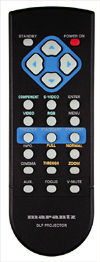Marantz VP-12S1 DLP Projector Page 2
The color decoding in the Marantz is quite good, but the primary green in the color wheel is lime green. When I looked  through a green filter at SMPTE color bars, I saw what I can only call a green push. This push is also discernible in regular program material like grass fields during sporting events. The green oak leaves from "Montage of Images" on the Video Essentials DVD looked just a tad on the neon side. In all fairness to Marantz, the Sharp and the SIM2 Grand Cinema HT300 both exhibit this problem with green, as well. When I checked the Y/C delay pattern on the Avia disc, the VP-12S1 showed virtually no chrominance-to-luminance delay.
through a green filter at SMPTE color bars, I saw what I can only call a green push. This push is also discernible in regular program material like grass fields during sporting events. The green oak leaves from "Montage of Images" on the Video Essentials DVD looked just a tad on the neon side. In all fairness to Marantz, the Sharp and the SIM2 Grand Cinema HT300 both exhibit this problem with green, as well. When I checked the Y/C delay pattern on the Avia disc, the VP-12S1 showed virtually no chrominance-to-luminance delay.
The second setup was in my own home theater with a 72-inch-wide Stewart Studiotek 130 screen, also driven by a Panasonic DVD-RP91 DVD player. I lowered the contrast to 70 and reset the black level, and I got an incredibly bright, snappy picture for both DVD and HD sources. Looking at the same scenes from Hollow Man and Jurassic Park III was equally enjoyable. Finally, I sat back and watched the Spy Game DVD from beginning to end. This is a very good-quality DVD transfer. It also has a 2.35:1 aspect ratio, so it provides good-sized black bars at the top and bottom of the image, which appeared very dark. While the VP-12S1's black-level performance isn't quite as good as that of a CRT projector, it's nonetheless impressive.
For my HD setup, I used the 15-pin RGB input and ran the component video out from my Dish Network box through an Extron CVC200 component-video-to-RGB transcoder. With my AccuPel HD signal generator, I put up test patterns and reset the contrast and black levels for 1080i. Take note here: To gain access to the contrast and brightness controls in RGB, you must turn off the high bright setting in the menu and be in mode 1, 2, or 3. If you're in the default mode, you won't be able to access these controls. After calibration, the HD feeds from HBO, Showtime, and the Dish Network demo loop looked fabulous.
I have to hand it to Marantz. They definitely have one of the industry's top 1,280-by-720 one-chip DLP projectors. The VP-12S1 has top-notch video processing courtesy of Faroudja, excellent setup flexibility, and build quality that's second to none in its category. The VP-12S1 does have a shorter throw distance than most DLP models, but that may be a boon to someone like me who has a small room in an urban area. I was pleasantly surprised to find that the VP-12S1 could drive very large screen sizes in spite of its relatively small lamp size. As a die-hard tweak, I was a little disappointed that I couldn't fine-tune the gray scale. At $12,495, the VP-12S1 is about in the middle of the price range for its category. Considering its outstanding performance, though, it represents an excellent value.
Highlights
• Excellent picture quality
• Good value in the 1,280-by-720 one-chip DLP-projector category

- Log in or register to post comments





























































